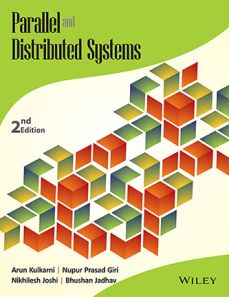Parallel and Distributed Systems, 2ed
ISBN: 9788126565825
360 pages
Publication Year: 2017
For more information write to us at: acadmktg@wiley.com

Description
This book covers the concepts of Parallel and Distributed Computing as emerging technologies are built on the top of parallel and distributed models. This book will be helpful to students and IT professionals. The book covers the concepts of Parallel Computing, Parallel Architectures, Programming Models, Parallel Algorithms, Pipeline Processing and Basics of Distributed System. This book aims to provide both theoretical and practical concepts through its chapter organization and program code in Java.
Preface
Acknowledgement
About the Authors
Chapter 1 Introduction to Parallel Computing
1.1 Introduction
1.2 Computing
1.3 Parallel Architecture
1.4 Classification Based on Architectural Schemes
1.5 Classification Based on Memory Access
1.6 Classification Based on Interconnections between PEs and Memory Modules
1.7 Classification Based on Characteristic Nature of Processing Elements
1.8 Performance Metrics
1.9 Parallel Programming Models
1.10 Serial and Parallel Algorithms
1.11 Parallelism
Chapter 2 Pipelining
2.1 Introduction
2.2 Pipeline Performance
2.3 Types of Pipeline
2.4 Pipeline Stage Design
2.5 Pipeline Hazards
2.6 Instruction Scheduling
Chapter 3 Synchronous Parallel Processing
3.1 Introduction
3.2 SIMD Architecture and Its Programming Principle
3.3 Single Instruction Multiple Data (SIMD) Parallel Algorithms
3.4 Data Mapping and Memory in Array Processor
3.5 Case Studies of SIMD Parallel Processors
Chapter 4 Introduction to Distributed Systems
4.1 Introduction
4.2 Definition
4.3 Goals of the Distributed System
4.4 Issues Related to the Distributed System
4.5 Types of Distributed System
4.6 Distributed System Models
4.7 Hardware Concept
4.8 Software Concept
4.9 Models of Middleware
4.10 Services Offered by Middleware System
4.11 Client–Server Model
Chapter 5 Communication
5.1 Introduction
5.2 Layered Protocols
5.3 Remote Procedure Call
5.4 Remote Object Invocation
5.5 Remote Method Invocation
5.6 Message-Oriented Communication
5.7 Stream-Oriented Communication
Chapter 6 Resource and Process Management
6.1 Resource Management in Distributed System
6.2 Desirable Features of Global Scheduling Algorithm
6.3 Scheduling in the Distributed System
6.4 Taxonomy of the Distributed Scheduling
6.5 Task Assignment Approach
6.6 Load Balancing Approach
6.7 Issues in Designing Load Balancing Algorithm
6.8 Load Sharing Approach
6.9 Introduction to Process Management
Chapter 7 Synchronization
7.1 Introduction: Clock Synchronization
7.2 Physical Clock
7.3 Logical Clock
7.4 Election Algorithms
7.5 Mutual Exclusion
7.6 Centralized Algorithm
7.7 Distributed Mutual Exclusion
Chapter 8 Replication, Consistency and Distributed File System
8.1 Introduction
8.2 Replication and Consistency
8.3 Replication Management
8.4 Distributed File Systems
8.5 Case Studies
Summary
Multiple Choice Questions
Short Answer Questions
Long Answer Questions
Answers
Practical No. 1
Practical No. 2
Practical No. 3
Practical No. 4
Practical No. 5
Practical No. 6
Practical No. 7
Practical No. 8
Practical No. 9
Practical No. 10
Practical No. 11
Practical No. 12
Index

